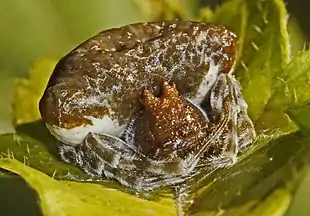Mastophora (spider)
Mastophora, also known as bolas spiders,[2] is a genus of orb-weaver spiders first described by E. L. Holmberg in 1876.[3] They can be identified by a pair of lumps on the dorsal surface of the opisthosoma, though not all males will have these lumps.[2]
| Bolas spiders | |
|---|---|
 | |
| M. phrynosoma female from Virginia | |
| Scientific classification | |
| Kingdom: | Animalia |
| Phylum: | Arthropoda |
| Subphylum: | Chelicerata |
| Class: | Arachnida |
| Order: | Araneae |
| Infraorder: | Araneomorphae |
| Family: | Araneidae |
| Subfamily: | Cyrtarachninae s.l. |
| Genus: | Mastophora Holmberg, 1876[1] |
| Type species | |
| M. extraordinaria Holmberg, 1876 | |
| Species | |
|
50, see text | |
| Synonyms[1] | |
| |
Adult females of the genus snare prey mid-air by using a silk line with an adhesive blob on the end, similar to bolas used by South American gauchos. They feed on flying insects, particularly moths, sometimes releasing pheromones that mimic those of their prey to attract them. Males and juvenile females capture their prey directly with their legs.[4][2]
Species

M. bisaccata egg sacs
_egg_sac%252C_Julie_Metz_Wetland%252C_Woodbridge%252C_Virginia.jpg.webp)
M. phrynosoma egg sac
As of April 2019 it contains fifty species:[1]
- Mastophora abalosi Urtubey & Báez, 1983 – Argentina
- Mastophora alachua Levi, 2003 – USA
- Mastophora alvareztoroi Ibarra & Jiménez, 2003 – USA, Mexico
- Mastophora apalachicola Levi, 2003 – USA
- Mastophora archeri Gertsch, 1955 – USA
- Mastophora bisaccata (Emerton, 1884) – USA, Mexico
- Mastophora brescoviti Levi, 2003 – Brazil
- Mastophora caesariata Eberhard & Levi, 2006 – Costa Rica
- Mastophora carpogaster Mello-Leitão, 1925 – Brazil
- Mastophora catarina Levi, 2003 – Brazil
- Mastophora comma Báez & Urtubey, 1985 – Argentina
- Mastophora conica Levi, 2006 – Argentina
- Mastophora conifera (Holmberg, 1876) – Argentina
- Mastophora cornigera (Hentz, 1850) – USA to Nicaragua
- Mastophora corpulenta (Banks, 1898) – Mexico, Honduras, Nicaragua, Brazil
- Mastophora corumbatai Levi, 2003 – Brazil
- Mastophora cranion Mello-Leitão, 1928 – Brazil
- Mastophora diablo Levi, 2003 – Argentina
- Mastophora dizzydeani Eberhard, 1981 – Colombia, Peru
- Mastophora escomeli Levi, 2003 – Peru
- Mastophora extraordinaria Holmberg, 1876 – Brazil, Uruguay, Argentina
- Mastophora fasciata Reimoser, 1939 – Costa Rica, Venezuela
- Mastophora felda Levi, 2003 – USA
- Mastophora felis Piza, 1976 – Brazil
- Mastophora gasteracanthoides (Nicolet, 1849) – Chile
- Mastophora haywardi Birabén, 1946 – Argentina
- Mastophora holmbergi Canals, 1931 – Paraguay, Argentina
- Mastophora hutchinsoni Gertsch, 1955 – USA, Canada
- Mastophora lara Levi, 2003 – Venezuela
- Mastophora leucabulba (Gertsch, 1955) – USA to Honduras
- Mastophora leucacantha (Simon, 1897) – Brazil
- Mastophora longiceps Mello-Leitão, 1940 – Brazil
- Mastophora melloleitaoi Canals, 1931 – Brazil, Argentina
- Mastophora obtusa Mello-Leitão, 1936 – Brazil
- Mastophora pesqueiro Levi, 2003 – Brazil
- Mastophora phrynosoma Gertsch, 1955 – USA
- Mastophora pickeli Mello-Leitão, 1931 – Brazil
- Mastophora piras Levi, 2003 – Brazil
- Mastophora rabida Levi, 2003 – Ecuador (Galapagos Is.)
- Mastophora reimoseri Levi, 2003 – Paraguay
- Mastophora satan Canals, 1931 – Brazil, Uruguay, Argentina
- Mastophora satsuma Levi, 2003 – USA
- Mastophora seminole Levi, 2003 – USA
- Mastophora soberiana Levi, 2003 – Panama
- Mastophora stowei Levi, 2003 – USA
- Mastophora timuqua Levi, 2003 – USA
- Mastophora vaquera Gertsch, 1955 – Cuba
- Mastophora yacare Levi, 2003 – Uruguay
- Mastophora yeargani Levi, 2003 – USA
- Mastophora ypiranga Levi, 2003 – Brazil
References
- "Gen. Mastophora Holmberg, 1876". World Spider Catalog. Natural History Museum Bern. Retrieved 2019-05-13.
- "Genus Mastophora". BugGuide. Retrieved 2019-05-13.
- Holmberg, E. L. (1876). "Arácnidos argentinos". Anales de Agricultura de la República Argentina. 4: 1–30.
- Levi, H.W. (2003). "The bolas spiders of the genus Mastophora (Araneae: Araneidae)". Bulletin of the Museum of Comparative Zoology. 157: 309–382.
This article is issued from Wikipedia. The text is licensed under Creative Commons - Attribution - Sharealike. Additional terms may apply for the media files.